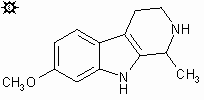
#54. TETRAHYDROHARMINE
HARMAN, 7-METHOXY-1,2,3,4-TETRAHYDRO; HARMINE, 1,2,3,4-TETRAHYDRO; b-CARBOLINE, 7-METHOXY-1-METHYL-1,2,3,4-TETRAHYDRO; 7-METHOXY-1,2,3,4-TETRAHYDROHARMAN; 1,2,3,4-TETRAHYDROHARMINE; 7-METHOXY-1-METHYL-1,2,3,4-TETRAHYDRO-b-CARBOLINE; 7-MEO-THH; LEPTAFLORINE

|
| [3D .mol structure] |
DOSAGE : 300 mg, orally
DURATION : unknown
QUALITATIVE COMMENTS : (with 300 mg, orally) "At this dosage level there were subjective effects similar to what I had experienced with 100 milligrams of harmaline."
EXTENSIONS AND COMMENTARY : This one comment is the sum total of what I can find in the literature concerning the human activity of tetrahydroharmine. It was a study done with the synthetic racemate, whereas the natural isolate is the dextrorotatory isomer. It was a single trial. It was carried out in a single volunteer. There is no information given as what this person's response had been to 100 milligrams harmaline. Tetrahydroharmine could very well be an extremely important factor in the study of plants known to promote materials such as DMT to oral activity. It is present (along with harmaline and harmine) in Peganum harmala, and has been reported as being present in level equal to those of harmine in the analyses of ayahuasaca samples (where harmaline itself is usually present in rather small amounts). And it is an effective monoamineoxidase inhibitor. The material is easily synthesized and it should not be difficult to resolve it into its optically opposite forms. Clinical studies would be extremely informative. In balance, the psychopharmacological activity of this plant isolate must be accepted as being essentially unknown.
The first isolation of tetrahydroharmine from the botanical world has an interesting story attached to it. The major alkaloid known to be in Banisteriopsis caapi (back in 1920's when the Genus was still called Banisteria) was harmine. Some reports a few years later reported the presence of harmaline, but it was not until the 1950's that a careful chromatographic analysis of the plant revealed a third alkaloid. The apparent optical activity was discounted, and the isolated material was thought to be 6-methoxy-N,N-dimethyltryptamine (6-MeO-DMT). This was synthesized, and it wasn't quite right. In chemistry, not quite right means out and out wrong. Then the racemic (optically inactive) form of tetrahydroharmine was synthesized and not only was it spectroscopically identical to the dextrorotatory plant isolate ([a]D +32°) but it had an identical infra-red spectrum, an identical melting point, and no depression with a mixed melting point. There are precious few optical isomers and racemates that can make that claim.
There are a number of other plants that are known to contain tetrahydroharmine and to have been used in various native preparations. I have recently learned of analysis of an Ayahuasca brew that had used the plant Calliandra pentandra as a component, instead of the usual Psychotria viridis. Ott's magnificent compendium Pharmacotheon makes mention of a Calliandra augustifolia as a component of ayahuasca, but there is no mention of this pentandra species. The preliminary analysis that I have been given of this decoction is that a component that had initially appeared to be DMT by HPLC analysis had proven to be tetrahydroharmine when assayed by GCMS. There was no detectable DMT present. And yet the material appears to have psychopharmacological activity.
More studies on tetrahydroharmine are absolutely imperative.
| [ |
[Main Index] | [Forward |

